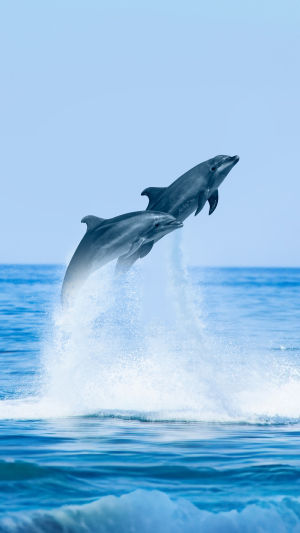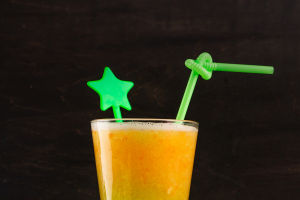If you've ever imagined what it would be like to meet a real “ocean spirit,” chances are you pictured a dolphin. With their playful energy, curious eyes, and warm personalities, dolphins have become one of the most loved animals on Earth.
But behind their charming appearance is a world full of intelligence, emotion, and challenges. Today, let's dive into their fascinating lives and explore how we, as fellow earthlings, can do more to understand and protect them.
<h3>Dolphins: The Ocean's Social Experts</h3>
Dolphins aren't just cute—they're some of the smartest and most social animals in the sea. They live in groups, talk to each other with unique whistles (yes, they each have their own name!), and work together to find food or protect their young. They mainly eat fish and squid, but they're also part of a larger food web, where bigger sea animals like sharks may hunt them. That's why dolphins play an important role in keeping the ocean's balance.
<h3>Nature's Ocean Health Report</h3>
Scientists call dolphins "indicators" of ocean health. That means by studying dolphins—like their behaviors or health conditions—we can figure out if the ocean is clean or polluted. If dolphins are getting sick or disappearing, it's often a warning sign for us too. Pollution in the sea doesn't just hurt marine life—it eventually affects our food and water as well.
<h3>So Many Types of Dolphins</h3>
Did you know “dolphin” isn't just one species? In fact, there are about 42 types! They're all part of a larger group of animals called "cetaceans," which includes whales and porpoises. Most dolphins live in oceans—from warm tropical waters to icy cold seas. But a few, like the Amazon river dolphin, actually live in freshwater!
Among them, the biggest is the orca, or killer whale, which can weigh up to 10 tons and grow 10 meters long. The smallest? That would be the Māui dolphin, often called the “Hobbit of the sea,” growing only to about 1.2 meters and living near New Zealand.
<h3>Dolphins Were Once Land Animals</h3>
Believe it or not, dolphins didn't always live in the water. Around 50 million years ago, their ancestors were land animals! You can still see clues today. Their flippers look a lot like the limbs of land animals, and their backbones move up and down (not side to side like fish), just like animals that walk. Dolphins also breathe air using a blowhole, which shows they're still mammals, just like us.
<h3>They Speak and Navigate with Sound</h3>
Every dolphin has a special whistle—like a name—and they use it to call each other. But that's not all. Dolphins also use echolocation, a kind of natural sonar. They send out high-pitched sounds that bounce off things in the water, helping them “see” with sound. It's how they find food and avoid obstacles, even in dark or murky waters.
<h3>Dolphins Are Super Smart</h3>
One standout example of dolphin intelligence is mirror recognition. A young bottlenose dolphin can recognize itself in a mirror by 7 months old. For humans, this usually happens at around age 2! Dolphins also know how to use tools. In Shark Bay, Australia, they protect their noses with sea sponges when digging for food around sharp rocks.
<h3>Strong Swimmers and Jumpers</h3>
Some dolphins can swim at 50 km/h and dive as deep as 55 meters to hunt fish, squid, and small shellfish. They spend about 17% of the day eating and half of the time cruising around their territory—which can be up to 400 square kilometers!
They need to hold their breath underwater, and some species, like the gray dolphin, can do it for 30 minutes! When swimming slowly, they come up for air once or twice per minute, but when they're zipping through the water, you'll often see them jump into the air to breathe.
Speaking of jumping—bottlenose dolphins can leap 5 meters out of the water! It's one of their most playful and energetic behaviors.
<h3>Life and Family of a Dolphin</h3>
Dolphins grow up at different rates depending on their species. Some mature at age 5, others not until 13. Pregnancies last from 9 to 16 months. Bottlenose dolphins usually have their first baby around age 5–7 and give birth every 2–3 years. They only have one baby at a time, and other dolphins in the group often help protect the newborn.
The babies are born tail-first (to avoid drowning) and rely on their mom's milk for about 3 years. In the wild, bottlenose dolphins live up to 30 years, and orcas can live as long as 80!
<h3>The Dark Side: Dolphins in Captivity</h3>
Over 3,000 dolphins are currently living in captivity, mostly bottlenose dolphins. Many were caught from the wild or born in confined breeding programs. They're forced to perform tricks and interact with tourists for money. According to research, the global dolphin tourism industry is worth up to $5.5 billion.
The largest pools in dolphin parks are only about 444 square meters—tiny compared to the wild, where dolphins can swim across hundreds of kilometers. These artificial environments can't provide what dolphins need: space, freedom, and choice.
On top of that, the performances, swimming sessions, and photo ops can cause stress, injuries, and even shorten their lives.
<h3>What Can We Do, Lykkers?</h3>
We believe every dolphin deserves a wild and free life. As Lykkers who care about animals and the planet, we can help by not supporting dolphin shows, speaking up for better laws, and supporting conservation groups. Remember, even small actions can ripple into big waves.
Next time you see a dolphin image or hear their whistles, we hope you remember just how smart, social, and special they are—and how much they need our help.
Let's keep the ocean safe, not just for dolphins, but for all of us.
Would you swim with a dolphin in the wild or observe them from a respectful distance? Let us know—we'd love to hear your thoughts, Lykkers!





